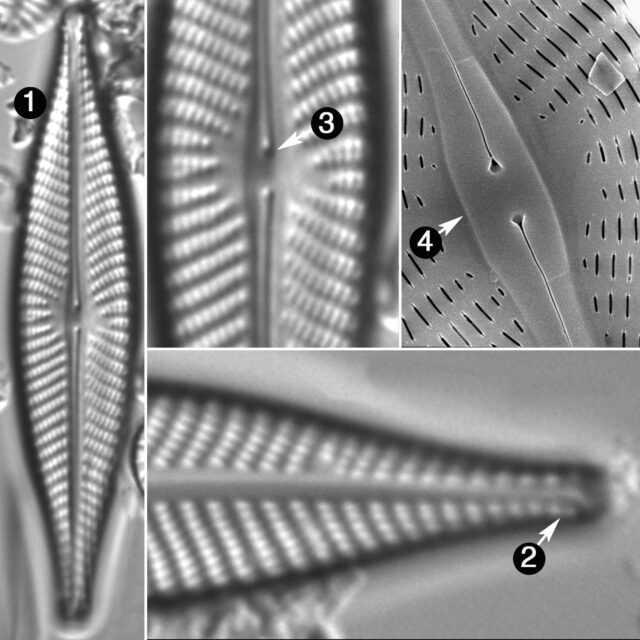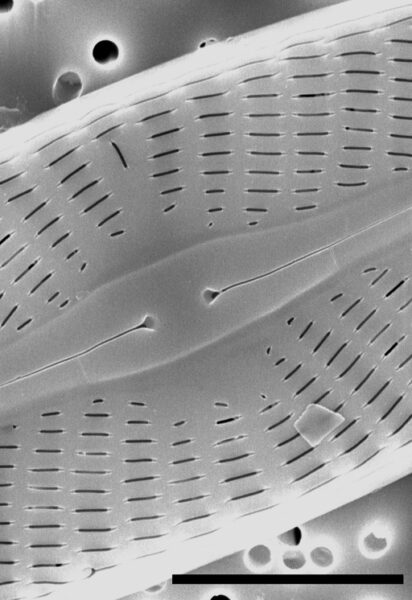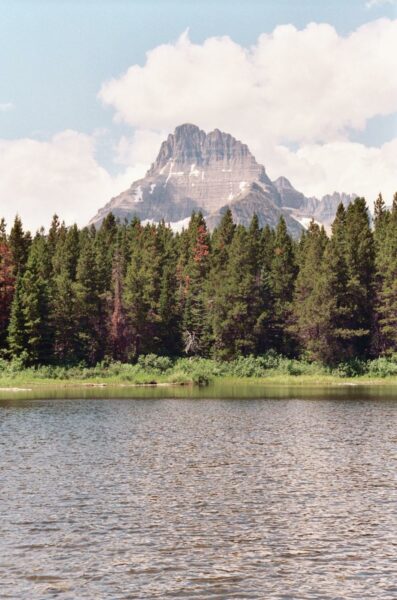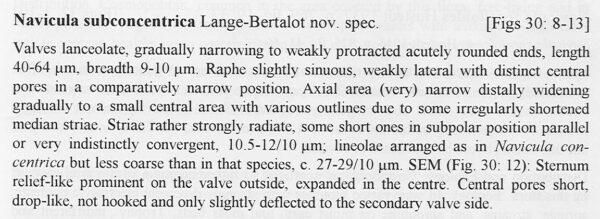Navicula subconcentrica
-
Category
-
Length Range36-58 µm
-
Width Range8.5-10.6 µm
-
Striae in 10 µm10-12
-
ContributorLoren Bahls - Nov 2011
-
ReviewerRex Lowe - Nov 2011
Identification
Description
Valves are lanceolate and narrow gradually to weakly protracted acutely rounded ends, or apices narrow abruptly to form protracted, subcapitate ends. The axial area is narrow and widens gradually to a small, more or less rhombic central area. The raphe sternum and central nodule appear raised in relief. The central nodule is half again wider than the raphe sternum and has flat or occasionally concave sides. The raphe is weakly lateral and nearly straight along the valve midline. Proximal raphe ends are nearly straight and relatively close together. Raphe pores are distinct and deltoid in shape. Terminal raphe fissures are hooked, the hooks opening toward the secondary side. The striae are strongly radiate throughout and become parallel only at the poles. Areolae in the striae are distinct and number 24-27 in 10 µm.
Autecology
There are 13 records of Navicula subconcentrica in the Montana Diatom Collection, most of them from lakes and ponds in the Canadian Rockies Ecoregion (Glacier and Waterton Lakes National Parks), where it prefers alkaline waters (mean pH = 8.2) of modest conductivity (mean SC = 315 µS/cm). Common diatom associates of N. subconcentrica in the Northern Rockies are Sellaphora parapupula, Navicula schadei, Navicula wildii, Placoneis explanata, Navicula jaagii, Cymbella transilvanica, Cymbella laevis v. lata, Fragilaria capucina v. austriaca, Cymbopleura inaequalis, Encyonopsis descripta, Cymbella frigida, and Neidium apiculatum. Lange-Bertalot (2001) described this species from material collected in an oligotrophic chalk-rich lake in Bavaria.
-
Size Range, µm3
-
Motility
-
Attachment
-
Habitat
-
Colony
-
Waterbody
- Learn more about this
Original Description
Valves lanceolate, gradually narrowing to weakly protracted acutely rounded ends, length 40-64 microns, breadth 9-10 microns. Raphe slightly sinuous, weakly lateral with distinct central pores in a comparatively narrow position. Axial area (very) narrow distally widening gradually to a small central area with various outlines due to some irregularly shortened median striae. Striae rather strongly radiate, some short ones in subpolar position parallel or very indistinctly convergent, 10.5-12/10 microns; lineolae arranged as in Navicula concentrica but less coarse than in that species, c. 27-29/10 microns. SEM (Fig. 30: 12): Sternum relief-like prominent on the valve outside, expanded in the centre. Central pores short, drop-like, not hooked and only slightly deflected to the secondary valve side.
-
AuthorLange-Bert. 2001
-
Length Range40-64 µm
-
Width9-10 µm
-
Striae in 10µm10.5-12.0
Citations & Links
Cite This Page
Bahls, L. (2011). Navicula subconcentrica. In Diatoms of North America. Retrieved April 23, 2024, from https://diatoms.org/species/navicula_subconcentrica
Responses
The 15 response plots show an environmental variable (x axis) against the relative abundance (y axis) of Navicula subconcentrica from all the stream reaches where it was present. Note that the relative abundance scale is the same on each plot. Explanation of each environmental variable and units are as follows:
ELEVATION = stream reach elevation (meters)
STRAHLER = distribution plot of the Strahler Stream Order
SLOPE = stream reach gradient (degrees)
W1_HALL = an index that is a measure of streamside (riparian) human activity that ranges from 0 - 10, with a value of 0 indicating of minimal disturbance to a value of 10 indicating severe disturbance.
PHSTVL = pH measured in a sealed syringe sample (pH units)
log_COND = log concentration of specific conductivity (µS/cm)
log_PTL = log concentration of total phosphorus (µg/L)
log_NO3 = log concentration of nitrate (µeq/L)
log_DOC = log concentration of dissolved organic carbon (mg/L)
log_SIO2 = log concentration of silicon (mg/L)
log_NA = log concentration of sodium (µeq/L)
log_HCO3 = log concentration of the bicarbonate ion (µeq/L)
EMBED = percent of the stream substrate that is embedded by sand and fine sediment
log_TURBIDITY = log of turbidity, a measure of cloudiness of water, in nephelometric turbidity units (NTU).
DISTOT = an index of total human disturbance in the watershed that ranges from 1 - 100, with a value of 0 indicating of minimal disturbance to a value of 100 indicating severe disturbance.

Navicula subconcentrica
- Valves lanceolate
- Valve ends narrow, acutely rounded to subcapitate
- Proximal raphe ends straight
- Central nodule with flat, or concave sides
Navicula subconcentrica has lanceolate valves that are less than 11 µm wide. Valve ends are narrow and acutely rounded, to subcapitate. The proximal raphe ends are nearly straight and relatively close together. The central nodule is typically symmetric, with flat or slightly concave sides.
 Diatoms of North America
Diatoms of North America










